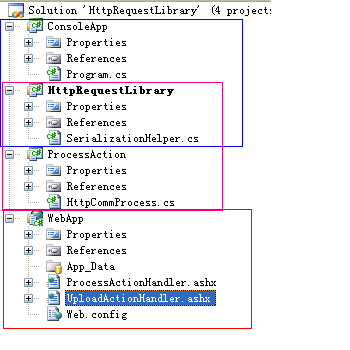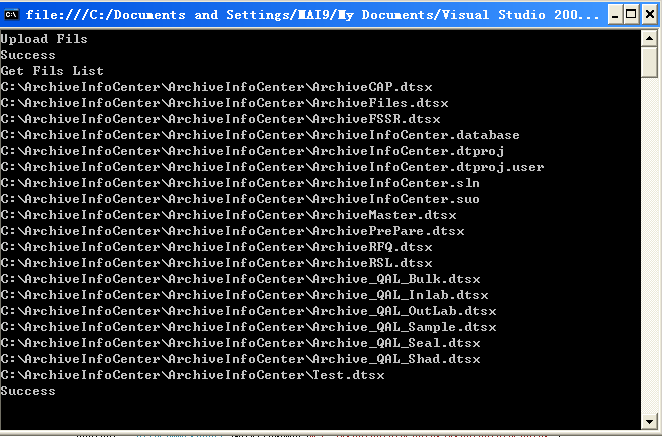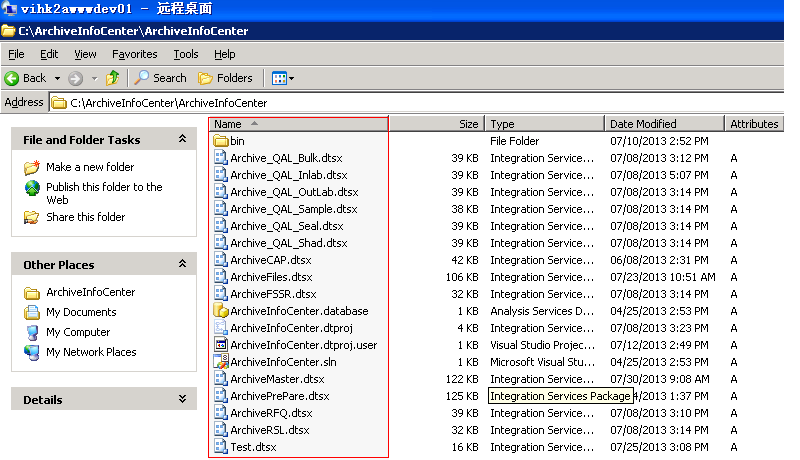昨天遇到一个比较奇怪的需求,大致是需要在服务器上部署一个http服务,但是服务的具体功能不知道,以后在客服端实现。这里介绍一下系统背景,有一个系统运(部署在美国)行了很多年了,给系统产生了很多文件,现在需要把该系统的文件(依据数据库中的记录)来做相应的archive,做了后发现里面还有一些独立的文件(不与数据库记录相关),那么这时我们需要删除这些独立的文件,或者把它们remove到其他地方,需要得到这些文件的list。后来想了想以后会不会还有别的什么需求啊,所以就想做一个通用的HTTPhandler了。这里说明一下:production时在美国,Archive在香港;在我们大陆的系统权限放的都比较开,在美国那个权限管的非常紧,我们是没有权限直接操作Production上的文件,所以才需要用http 协议来做。这里的http server部署到US,而client 却部署到hk。
整个解决方案如图:

其中
WebApp项目部署到Production上(us)
ConsoleApp部署到archive上(hk)
HttpRequestLibrary 是一个对象序列化的通用类以及一个请求类的包装,WebApp和ConsoleApp都需要引用该dll
ProcessAction是在客户端实现的,但是在服务器端反序列化是必须有该文件,所以该dll将会从client 上传到Production上。
首先我们来看看服务器端的实现:
首先需要创建一个ProcessActionHandler.ashx来处理客户端的调用:
public class ProcessActionHandler : IHttpHandler { public void ProcessRequest(HttpContext context) { context.Response.ContentType = "text/plain"; try { string inputstring = ReadInputStream(); if (!string.IsNullOrEmpty(inputstring)) { HttpRequestInfo requestinfo = inputstring; if (requestinfo.Process != null) { requestinfo.Process(requestinfo); } } else { //context.Response.StatusCode = 404; context.Response.Write("input error message"); } } catch (Exception ex) { context.Response.Write(ex.Message); } } private string ReadInputStream() { StringBuilder inputString = new StringBuilder(); using (Stream sr = HttpContext.Current.Request.InputStream) { byte[] data = new byte[1024 * 100]; int readCount = sr.Read(data, 0, data.Length); while (readCount > 0) { string text = Encoding.UTF8.GetString(data, 0, readCount); inputString.Append(text); readCount = sr.Read(data, 0, data.Length); } } return inputString.ToString(); } public bool IsReusable { get { return false; } } }
这里的HttpRequestInfo类是客户端创建的,这里调用HttpRequestInfo的Process方法也是客户端实现的。如何才能获得客户端的实现了,我们需要把客户端实现的dll文件上传到服务器上。
所以需要创建一个UploadActionHandler.ashx来上传客户端的处理:
public class UploadActionHandler : IHttpHandler { public void ProcessRequest(HttpContext context) { context.Response.ContentType = "text/plain"; string baseFilePath = context.Server.MapPath("Bin"); if (context.Request.Files.Count > 0) { try { HttpPostedFile file = context.Request.Files[0]; FileInfo fileInfo = new FileInfo(file.FileName); if (fileInfo.Extension.Equals(".dll")) { string tempPath = tempPath = Path.Combine(baseFilePath, fileInfo.Name); file.SaveAs(tempPath); context.Response.Write("Success"); } else { context.Response.Write("Failed: There only upload dll file"); } } catch (Exception ex) { context.Response.Write("Failed: " + ex.Message); } } else { context.Response.Write("Failed: The Request has not upload file"); } } public bool IsReusable { get { return false; } } }
那么对象时如何序列化和反序列化,以及HttpRequestInfo的定义是什么样的了,这就要参考我们的HttpRequestLibrary项目了。
 View Code
View Code
namespace HttpRequestLibrary
{
using System;
using System.Collections.Generic;
using System.IO;
using System.Net;
using System.Runtime.Remoting.Messaging;
using System.Runtime.Serialization.Formatters.Binary;
using System.Runtime.Serialization.Formatters.Soap;
using System.Text;
using System.Web;
public enum FormatterType
{
/// <summary>
/// SOAP消息格式编码
/// </summary>
Soap,
/// <summary>
/// 二进制消息格式编码
/// </summary>
Binary
}
public static class SerializationHelper
{
private const FormatterType DefaultFormatterType = FormatterType.Binary;
/// <summary>
/// 按照串行化的编码要求,生成对应的编码器。
/// </summary>
/// <param name="formatterType"></param>
/// <returns></returns>
private static IRemotingFormatter GetFormatter(FormatterType formatterType)
{
switch (formatterType)
{
case FormatterType.Binary: return new BinaryFormatter();
case FormatterType.Soap: return new SoapFormatter();
}
throw new NotSupportedException();
}
/// <summary>
/// 把对象序列化转换为字符串
/// </summary>
/// <param name="graph">可串行化对象实例</param>
/// <param name="formatterType">消息格式编码类型(Soap或Binary型)</param>
/// <returns>串行化转化结果</returns>
/// <remarks>调用BinaryFormatter或SoapFormatter的Serialize方法实现主要转换过程。
/// </remarks>
public static string SerializeObjectToString(object graph, FormatterType formatterType)
{
using (MemoryStream memoryStream = new MemoryStream())
{
IRemotingFormatter formatter = GetFormatter(formatterType);
formatter.Serialize(memoryStream, graph);
Byte[] arrGraph = memoryStream.ToArray();
return Convert.ToBase64String(arrGraph);
}
}
public static string SerializeObjectToString(object graph)
{
return SerializeObjectToString(graph, DefaultFormatterType);
}
/// <summary>
/// 把已序列化为字符串类型的对象反序列化为指定的类型
/// </summary>
/// <param name="serializedGraph">已序列化为字符串类型的对象</param>
/// <param name="formatterType">消息格式编码类型(Soap或Binary型)</param>
/// <typeparam name="T">对象转换后的类型</typeparam>
/// <returns>串行化转化结果</returns>
/// <remarks>调用BinaryFormatter或SoapFormatter的Deserialize方法实现主要转换过程。
/// </remarks>
public static T DeserializeStringToObject<T>(string graph, FormatterType formatterType)
{
Byte[] arrGraph = Convert.FromBase64String(graph);
using (MemoryStream memoryStream = new MemoryStream(arrGraph))
{
IRemotingFormatter formatter = GetFormatter(formatterType);
return (T)formatter.Deserialize(memoryStream);
}
}
public static T DeserializeStringToObject<T>(string graph)
{
return DeserializeStringToObject<T>(graph, DefaultFormatterType);
}
}
[Serializable]
public class HttpRequestInfo
{
public HttpRequestInfo()
{
ContentData = new byte[0];
CommData = new Dictionary<string, string>();
}
public byte[] ContentData { set; get; }
public Action<HttpRequestInfo> Process { set; get; }
public Dictionary<string, string> CommData { set; get; }
public override string ToString()
{
string graph = SerializationHelper.SerializeObjectToString(this);
return graph;
}
public static implicit operator HttpRequestInfo(string contentString)
{
return SerializationHelper.DeserializeStringToObject<HttpRequestInfo>(contentString);
}
}
}
那么客服端如何来操作服务器端了,需要查看ProcessAction项目的实现了:
 View Code
View Code
using System;
using System.Collections.Generic;
using System.Linq;
using System.Text;
using System.Net;
using System.IO;
using HttpRequestLibrary;
using System.Web;
namespace ProcessAction
{
public class HttpCommProcess
{
public static bool UploadFile(string address, string fileNamePath, out string error)
{
try
{
error = string.Empty;
string strBoundary = "----------" + DateTime.Now.Ticks.ToString("x");
byte[] boundaryBytes = Encoding.ASCII.GetBytes("
--" + strBoundary + "
");
StringBuilder sb = new StringBuilder();
sb.Append("--");
sb.Append(strBoundary);
sb.Append("
");
sb.Append("Content-Disposition: form-data; name="");
sb.Append("file");
sb.Append(""; filename="");
sb.Append(fileNamePath);
sb.Append(""");
sb.Append("
");
sb.Append("Content-Type: ");
sb.Append(@"applicationoctet-stream");
sb.Append("
");
sb.Append("
");
string strPostHeader = sb.ToString();
byte[] postHeaderBytes = Encoding.UTF8.GetBytes(strPostHeader);
HttpWebRequest httpReq = (HttpWebRequest)WebRequest.Create(new Uri(address));
httpReq.Method = "POST";
httpReq.AllowWriteStreamBuffering = false;
httpReq.Timeout = 300000;
httpReq.ContentType = "multipart/form-data; boundary=" + strBoundary;
string responseText = string.Empty;
using (FileStream fs = new FileStream(fileNamePath, FileMode.Open, FileAccess.Read))
{
BinaryReader r = new BinaryReader(fs);
httpReq.ContentLength = fs.Length + postHeaderBytes.Length + boundaryBytes.Length; ;
byte[] buffer = new byte[fs.Length];
int size = r.Read(buffer, 0, buffer.Length);
using (Stream postStream = httpReq.GetRequestStream())
{
postStream.Write(postHeaderBytes, 0, postHeaderBytes.Length);
postStream.Write(buffer, 0, size);
postStream.Write(boundaryBytes, 0, boundaryBytes.Length);
}
}
WebResponse webRespon = httpReq.GetResponse();
using (StreamReader s = new StreamReader(webRespon.GetResponseStream()))
{
responseText = s.ReadToEnd();
}
if (responseText.Contains("Success"))
{
return true;
}
else
{
error = "UploadFile :" + responseText;
return false;
}
}
catch (Exception ex)
{
error = "UploadFile:" + ex.Message;
return false;
}
}
public static void SendHttpRequestData( string url,string reuestContent)
{
try
{
HttpWebRequest request = (HttpWebRequest)HttpWebRequest.Create(url);
request.Method = "POST";
request.ContentType = "text/xml";
request.KeepAlive = false;
request.UserAgent = "Mozilla/4.0 (compatible; MSIE 6.0; Windows NT 5.2; .NET CLR 1.0.3705;)";
using (Stream sr = request.GetRequestStream())
{
byte[] data = Encoding.UTF8.GetBytes(reuestContent);
sr.Write(data, 0, data.Length);
}
HttpWebResponse response = (HttpWebResponse)request.GetResponse();
if (response.StatusCode == HttpStatusCode.OK)
{
StringBuilder responseMessage = new StringBuilder();
using (Stream sr = response.GetResponseStream())
{
byte[] data = new byte[1024 * 10];
int readcount = sr.Read(data, 0, data.Length);
while (readcount > 0)
{
string str = Encoding.UTF8.GetString(data, 0, readcount);
responseMessage.Append(str);
readcount = sr.Read(data, 0, data.Length);
}
Console.WriteLine(responseMessage);
}
}
}
catch (Exception ex)
{
Console.WriteLine(ex.Message);
}
}
public static string GetUploadFileContent(string filename)
{
HttpRequestInfo requestInfo = new HttpRequestInfo();
FileInfo file = new FileInfo(filename);
requestInfo.CommData.Add("FileName", file.Name);
requestInfo.ContentData = new byte[file.Length];
using (Stream sr = File.OpenRead(filename))
{
sr.Read(requestInfo.ContentData, 0, requestInfo.ContentData.Length);
}
requestInfo.Process = (x) =>
{
try
{
string tempfile = Path.Combine(@"c: est", x.CommData["FileName"]);
using (Stream wr = File.Open(tempfile, FileMode.OpenOrCreate, FileAccess.Write))
{
wr.Write(x.ContentData, 0, x.ContentData.Length);
}
HttpContext.Current.Response.Write("Success");
}
catch (Exception ex)
{
HttpContext.Current.Response.Write(ex.Message);
}
};
return requestInfo.ToString();
}
public static string GetFileNames(string folderpath)
{
HttpRequestInfo requestInfo = new HttpRequestInfo();
requestInfo.CommData.Add("FolderPath", folderpath);
requestInfo.Process = (x) =>
{
try
{
DirectoryInfo dir=new DirectoryInfo( x.CommData["FolderPath"]);
foreach (FileInfo item in dir.GetFiles())
{
HttpContext.Current.Response.Write(item.FullName+Environment.NewLine);
}
HttpContext.Current.Response.Write("Success");
}
catch (Exception ex)
{
HttpContext.Current.Response.Write(ex.Message);
}
};
return requestInfo.ToString();
}
}
}
这里我们来看看GetFileNames方法的实现吧:
public static string GetFileNames(string folderpath) { HttpRequestInfo requestInfo = new HttpRequestInfo(); requestInfo.CommData.Add("FolderPath", folderpath); requestInfo.Process = (x) => { try { DirectoryInfo dir=new DirectoryInfo( x.CommData["FolderPath"]); foreach (FileInfo item in dir.GetFiles()) { HttpContext.Current.Response.Write(item.FullName+Environment.NewLine); } HttpContext.Current.Response.Write("Success"); } catch (Exception ex) { HttpContext.Current.Response.Write(ex.Message); } }; return requestInfo.ToString(); } }
很显然这里的Process就是服务器端将要call的回调函数。那么这个处理很显然是在客户端,服务器端如何才能识别了,就需要把该代码上传到服务器端。
那么最终客服端该如何调用该代码了:
static void Main(string[] args) { string error = string.Empty; bool uploaded = HttpCommProcess.UploadFile("http://vihk2awwwdev01/webapp/UploadActionHandler.ashx", Path.Combine(AppDomain.CurrentDomain.BaseDirectory, "ProcessAction.dll"), out error); if (!uploaded) { Console.WriteLine(error); } else { ///upload file string content = HttpCommProcess.GetUploadFileContent(@"C:IPC.LOG"); Console.WriteLine("Upload Fils"); HttpCommProcess.SendHttpRequestData("http://vihk2awwwdev01/webapp/ProcessActionHandler.ashx", content); //get file List content = HttpCommProcess.GetFileNames(@"C:ArchiveInfoCenterArchiveInfoCenter"); Console.WriteLine("Get Fils List"); HttpCommProcess.SendHttpRequestData("http://vihk2awwwdev01/webapp/ProcessActionHandler.ashx", content); } Console.ReadLine(); }
首先上传dll文件,然后在发送http请求,运行结果如图:
客户端结果:

服务器文件上传结果(这里只能上传小文件,大文件序列化和反序列化会很慢很慢)

服务器上原文件目录:

在某种程度上我也不赞成这样做,会很危险的。这里只是纯粹从技术的角度来讲如何实现,有不好的地方还请大家拍砖。
源码地址:http://download.csdn.net/detail/dz45693/5856523
